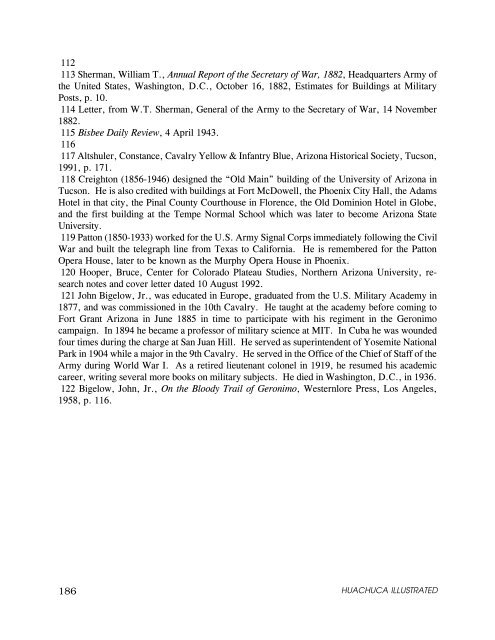Apache Campaigns - Fort Huachuca - U.S. Army
Apache Campaigns - Fort Huachuca - U.S. Army
Apache Campaigns - Fort Huachuca - U.S. Army
Create successful ePaper yourself
Turn your PDF publications into a flip-book with our unique Google optimized e-Paper software.
112<br />
113 Sherman, William T., Annual Report of the Secretary of War, 1882, Headquarters <strong>Army</strong> of<br />
the United States, Washington, D.C., October 16, 1882, Estimates for Buildings at Military<br />
Posts, p. 10.<br />
114 Letter, from W.T. Sherman, General of the <strong>Army</strong> to the Secretary of War, 14 November<br />
1882.<br />
115 Bisbee Daily Review, 4 April 1943.<br />
116<br />
117 Altshuler, Constance, Cavalry Yellow & Infantry Blue, Arizona Historical Society, Tucson,<br />
1991, p. 171.<br />
118 Creighton (1856-1946) designed the “Old Main” building of the University of Arizona in<br />
Tucson. He is also credited with buildings at <strong>Fort</strong> McDowell, the Phoenix City Hall, the Adams<br />
Hotel in that city, the Pinal County Courthouse in Florence, the Old Dominion Hotel in Globe,<br />
and the first building at the Tempe Normal School which was later to become Arizona State<br />
University.<br />
119 Patton (1850-1933) worked for the U.S. <strong>Army</strong> Signal Corps immediately following the Civil<br />
War and built the telegraph line from Texas to California. He is remembered for the Patton<br />
Opera House, later to be known as the Murphy Opera House in Phoenix.<br />
120 Hooper, Bruce, Center for Colorado Plateau Studies, Northern Arizona University, research<br />
notes and cover letter dated 10 August 1992.<br />
121 John Bigelow, Jr., was educated in Europe, graduated from the U.S. Military Academy in<br />
1877, and was commissioned in the 10th Cavalry. He taught at the academy before coming to<br />
<strong>Fort</strong> Grant Arizona in June 1885 in time to participate with his regiment in the Geronimo<br />
campaign. In 1894 he became a professor of military science at MIT. In Cuba he was wounded<br />
four times during the charge at San Juan Hill. He served as superintendent of Yosemite National<br />
Park in 1904 while a major in the 9th Cavalry. He served in the Office of the Chief of Staff of the<br />
<strong>Army</strong> during World War I. As a retired lieutenant colonel in 1919, he resumed his academic<br />
career, writing several more books on military subjects. He died in Washington, D.C., in 1936.<br />
122 Bigelow, John, Jr., On the Bloody Trail of Geronimo, Westernlore Press, Los Angeles,<br />
1958, p. 116.<br />
186<br />
HUACHUCA ILLUSTRATED

















